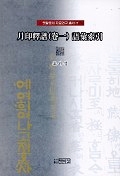| CHO, Eui-sung ( | ) |
| Work |
| Worin Seokbo (gwon 1) Eohwi Saegin |
| Bagijeong, 2002, 282P, ISBN 89-7878-573-5, 10000 Won (In Korean) |
 |
KWIC indices of Middle Korean with the computer programme
which author made uniquely. This book contains three type of indices
-- index in normal order, index in reverse order and index of suffixes.
The text of Worin Seokbo has footnotes about linguistic analysis. - Contents - Introduction Comments about footnotes Text of Worin Seokbo Vol.1 KWIC Index of Worin Seokbo Vol.1 (in Normal Order) KWIC Index of Worin Seokbo Vol.1 (in Reverse Order) KWIC Index of Worin Seokbo Vol.1 (Suffixes) |
| Summaries of Papers |
| On the Case {-'ei-se} in Modern Korean |
| Chosen Gakuho, Vol 150, Chosen Gakkai, 1995, pp.19-72 (in Japanese) |
| On the Word-Combination(slovosochetanie) in Modern Korean |
| Chosen Gakuho, Vol 163, Chosen Gakkai, 1997, pp.1-36 (in Korean) |
| On the Case {-'ei} in Modern Korean |
| Report of 4th Osaka-Asia Scholarship, Osaka International House Foundation, 1996, pp.15-23 (in Japanese) |
| On Computer Processing of Korean Text -- In Case of KWIC Index Composing of Middle Korean |
| The Bulletin of Niigata Women's College, 2000, pp.153-167 (in Japanese) |
| The Word-Combination Theories of North Korea and Former Soviet Union |
| Journal of Korean Linguistics, Vol. 38, The Society of Korean Linguistics, 2001, pp.305-327 (in Korean) |
| A Note on Accentual System in Middle Korean |
| Chosengo Kenkyu 1, Chosengo Kenkyukai, 2002, pp.57-64 |
| Summaries of Presentations |
| On the Accentual System of the 15th Century Korean |
| 26th gug-'e hag-hoi, Dec. 1999 (in Korean) |
| -de- | I, II | de+ | `O | IV da+ | `O | ||||
| -n@- | I, II | n@- | O | IV no+ | `O |
| strong border: | sy+re+//di+ge-nyr+ | `OO//`OOO = HH//HLH | |
| strong border: | 'u+ri-//d@r+h@r+ | `OO/`OOO = HL//HH |
| Word-Combination Theories in DPRK and the former USSR |
| 171st Chosengo Kenkyukai, Nov. 2000 (in Japanese) |